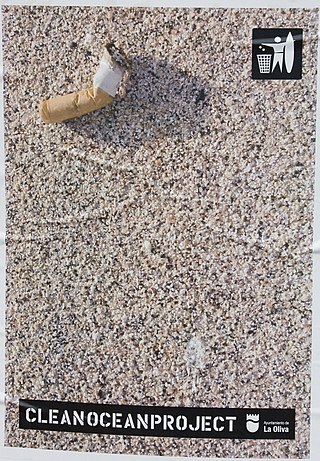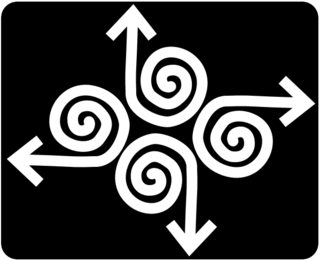
Conservation in Australia is an issue of state and federal policy. Australia is one of the most biologically diverse countries in the world, with a large portion of species endemic to Australia. Preserving this wealth of biodiversity is important for future generations.

Environmental protection is the practice of protecting the natural environment by individuals, groups and governments. Its objectives are to conserve natural resources and the existing natural environment and, where possible, to repair damage and reverse trends.

Conservation Volunteers Australia is an Australian not-for-profit conservation organisation that attracts and co-ordinates volunteers for environmental restoration projects.

The Australian Conservation Foundation (ACF) is Australia's national environmental organisation, launched in 1965 in response to a proposal by the World Wide Fund for Nature for a more co-ordinated approach to sustainability.
The Gould League is an independent Australian organisation promoting environmental education, founded in Victoria in 1909 and named after the English ornithologist John Gould. Largely autonomous branches were subsequently established in other Australian states.
Landcare Australia is the name for a community not-for-profit organisation which involves local groups of volunteers repairing the natural environment. Originally projects focused on agricultural farmland. The idea was that farmers, conservationists and scientists could work together to improve both farm quality and natural ecosystems.

The Greens (WA) is a member party of the Australian Greens in Western Australia. The Greens (WA) was formed following the merger of the Western Australian Green Party with the Green Earth Alliance composed of the Vallentine Peace Group and Alternative Coalition in 1990. The Party became officially affiliated with the Australian Greens in 2003.
Field & Game Australia (FGA) is an Australian non-government organization formed in 1958 for conservation, hunting and clay target shooting, and is based in Seymour, Victoria.
The Campaign Against Nuclear Energy (CANE) was established in Perth, Western Australia on 14 February 1976 by Friends of the Earth (FOE). It included Peter Brotherton, John Carlin, Mike Thomas and Barrie Machin. CANE was a non-profit grass roots organisation whose aim was to stop the establishment of a nuclear power plant in Western Australia (WA) and to halt uranium mining. The organisation operated out of the Environment Centre in Wellington Street, Perth. The Whitlam Federal government in 1974 had dedicated about A$7,000 per state to set up Regional Environment Centres. Perth's Environment Centre housed other groups including the Australian Conservation Foundation, the Conservation Council of Western Australia, Friends of the Earth, and the Campaign to Save Native Forests. A CANE group was also established in Adelaide, South Australia.
The Queensland Conservation Council (QCC) or Queensland Conservation is a non-governmental organisation that represents all the major conservation organisations of Queensland state in Australia. The organisation have been working to protect, conserve and sustain Queensland’s unique natural environment since 1969. The organisation's office is currently located in West End, Brisbane.
The Conservation Council of Western Australia is the umbrella body for conservation groups and organisations in Western Australia. It has been the co-ordinator, publisher and guiding body for issues of woodchipping in the South West of Western Australia, the logging of old growth forests, as well as providing input into government processes involved with all aspects of environmental protection and conservation.

Land clearing in Australia describes the removal of native vegetation and deforestation in Australia. Land clearing involves the removal of native vegetation and habitats, including the bulldozing of native bushlands, forests, savannah, woodlands and native grasslands and the draining of natural wetlands for replacement with agriculture, urban and other land uses.
The Conservation Council of South Australia, also known as Conservation SA and Conservation Council SA, is an environmental organisation serving as a peak body, representing over 50 member groups, representing over 90,000 individual members, in the state of South Australia.

Beginning as a conservation movement, the environmental movement in Australia was the first in the world to become a political movement. Australia is home to United Tasmania Group, the world's first green party.

Community forestry is an evolving branch of forestry whereby the local community plays a significant role in forest management and land use decision making by themselves in the facilitating support of government as well as change agents. It involves the participation and collaboration of various stakeholders including community, government and non-governmental organisations (NGOs). The level of involvement of each of these groups is dependent on the specific community forest project, the management system in use and the region. It gained prominence in the mid-1970s and examples of community forestry can now be seen in many countries including Nepal, Indonesia, Korea, Brazil, India and North America.

Established in 1965, the Yellingbo Nature Conservation Reserve is located 45 km east of Melbourne in the Upper Yarra Valley, near the towns of Yellingbo, Launching Place, Yarra Junction, Hoddles Creek, Cockatoo, Emerald, Monbulk and Seville. Yellingbo Nature Conservation Reserve is a narrow riparian reserve with stream-frontage land along the Woori Yallock, Shepherd, Cockatoo, Macclesfield and Sheep Station Creeks.
Save Our Marine Life (SOML) is an Australian not-for-profit, non-governmental environmental advocacy alliance working to protect and secure Australia's marine life. It is a collaboration of 29 non-profit conservation organisations, both Australian and international. SOML was initially founded in 2008 to raise awareness of the need for the Australian Government to establish a network of large marine sanctuaries in the country's South West marine region. In 2010 SOML became a national campaign in order to drive the completion of Australia's National Network of Marine Parks.

Australia's National Reserve System (NRS) is a network of more than 10,000 Commonwealth plus state and territory protected areas which, in combination, on a national scale, protect more than 137 million hectares, greater than 17% of the continent, of unique biodiversity and most significant ecological landscapes for future generations. The aim of the NRS is protect the diversity of all native landscapes, flora and fauna across Australia through strategic habitat protection. It consists of public, indigenous and privately protected areas of land and inland freshwaters.

The Federal Council for the Advancement of Aborigines and Torres Strait Islanders (FCAATSI), founded in Adelaide, South Australia, as the Federal Council for Aboriginal Advancement (FCAA) on 16 February 1958, was a civil rights organisation which campaigned for the welfare of Aboriginal Australians and Torres Strait Islanders, and the first national body representing Aboriginal interests. It was influential in lobbying in favour of the 1967 Referendum on Aboriginal Australians. It was renamed to National Aboriginal and Islander Liberation Movement (NAILM) in the early to mid 1970s, before disbanding in 1978.











